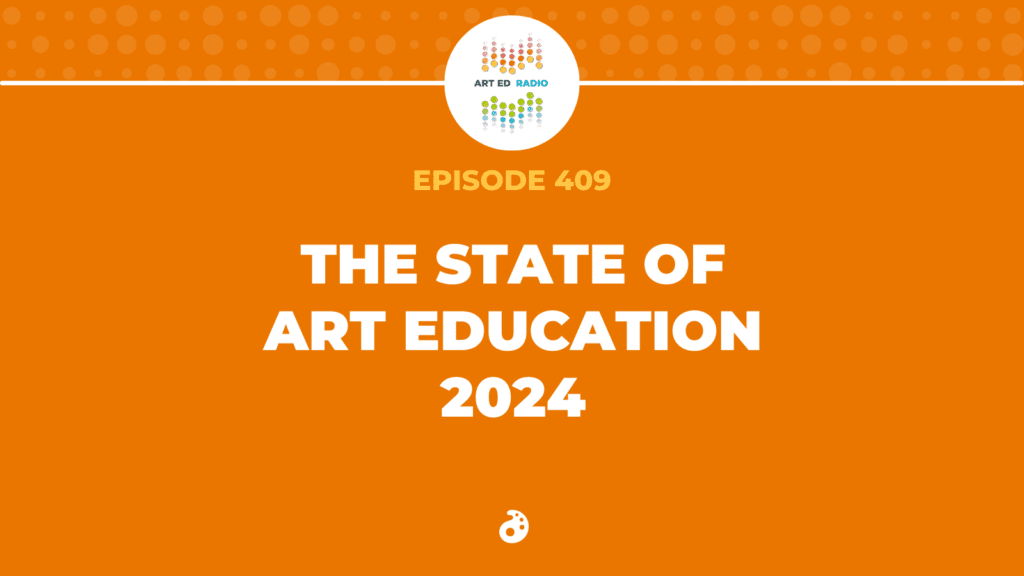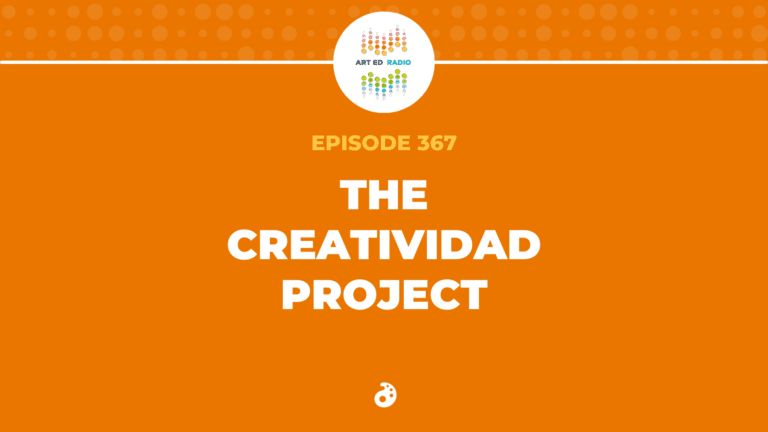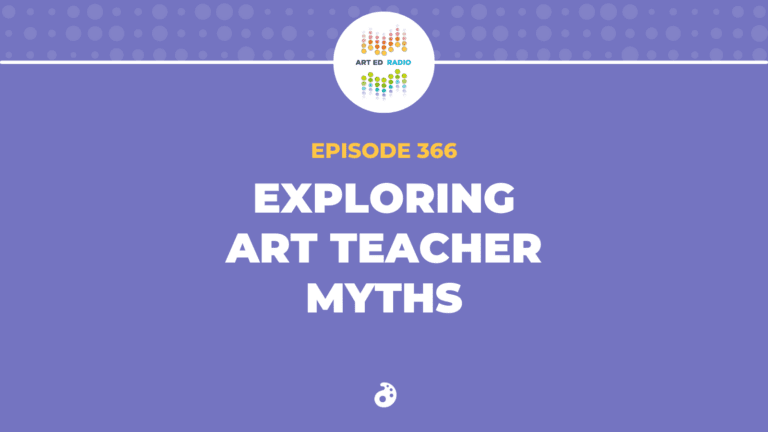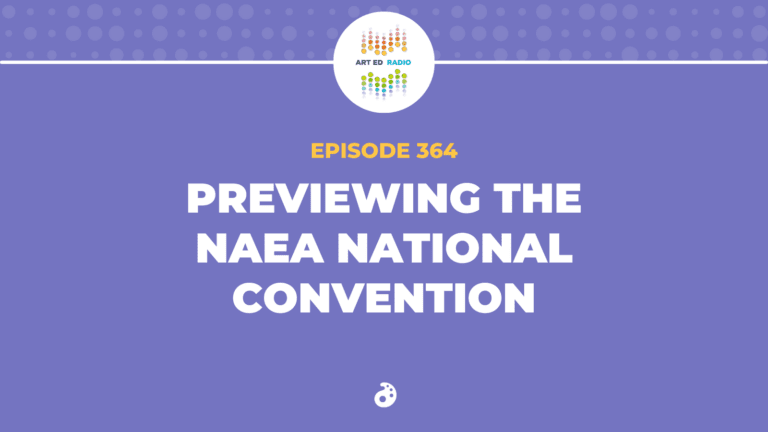Every year, AOEU surveys art teachers from across the country and around the world to capture the current issues, trends, and topics in art education. After data is collected from thousands of art teachers, the annual State of Art Education survey is published in the AOEU Magazine. The 2024 report was published on Friday, and Amanda Heyn and Lindsey McGinnis are on the podcast to discuss the results! Listen as they talk about the most interesting insights from the survey, their own top takeaways, and how teachers everywhere can use the survey to advocate for their art rooms and their programs. Full episode transcript below.
Resources and Links
- The State of Art Education 2024
- 6 Steps to Communicate with Stakeholders and Benefit Your Program
- Crafting your elevator pitch
- Take a look at the NOW Conference

Transcript
Tim:
Welcome to Art Ed Radio, the podcast for art teachers. The show is produced by the Art of Education University, and I’m your host, Tim Bogatz.
Each year, AOEU asks teachers to answer questions about a variety of topics in art education, and we put all of that together into what we call the State of Art Ed Survey. And we’re going to talk about that today.
In this survey, we are asking people to share their experience, their thoughts on all of the trends and topics and issues in art education. And honestly, art teachers come through. It’s fantastic.
We have so many people that engage with and answer the survey, and we get a really good picture of what’s going on in the art ed world. So we compile all of those results into a downloadable resource.
And then, along with that, we have an article in the AOEU magazine that just published on Friday, so obviously, we’ll link to that, so you can read that. We are going to discuss it today.
But just one other thing real quick. We’ve been doing the survey since 2018, I think, and every year, there are just some fascinating insights, and it’s always really interesting to me to see what teachers have to say, both what has stayed consistent for those years, and what is changing.
And today on the podcast, I’ll have Lindsey McGinnis and Amanda Hein with me, and we’re going to share some of our thoughts on the State of Art Ed Survey results, some of our opinions. I also want to ask both of them to talk about how you might be able to use some of these survey results to advocate for yourself, and your program.
We will get their expertise, as well, but we have a lot to explore here. So let me bring them on now.
All right. I have Lindsey McGuinness and Amanda Heyn joining me today for the podcast. Lindsey, how are you?
Lindsey:
Hey, Tim. I’m doing well.
Tim:
Excellent. Thanks for coming. And Amanda, how are you?
Amanda:
I am also doing great. I’m so excited to talk about data.
Tim:
We’re always excited to talk about data. So yeah, we’re going to jump in today, because we have a lot of data, and a lot of fun things to chat about with that data.
But I guess to get started, I would just love, Lindsey, if you could, to just kind of explain what the State of Art Ed Survey is. I talked about a little bit in the intro, but I would like the official explanation, since you’re in charge.
Lindsey:
The official explanation, since I’m in charge?
Amanda:
I feel like you need a sound.
Lindsey:
Yeah.
Amanda:
I know it’s not the mailbag, but like, da-ding. I don’t know. That’s what I got.
Tim:
You’re putting a lot of pressure on me here, Amanda.
Lindsey:
Well, every fall, we put out a survey on the magazine. That’s where you can find it. We ask art teachers from everywhere to answer some questions about their job, and art education, trends, topics, and issues.
We compile all the data over the winter, and around this time, we put out all of the results in a download, has a lot of easy to read graphics, and some takeaways, in another magazine article. This year, we had over 1,700 art teachers take the survey, which is really good.
Tim:
Yeah, that’s awesome. I love seeing so many people participating in that. And I remember, when we first started, I was afraid we’re going to get 14 people to pull out the survey, but there were literally thousands, and there are thousands every year.
So I feel like, it’s a really good snapshot. We get a really good perspective of what’s going on. And then. I guess, speaking of our first year of doing this, Amanda, you’ve worked here approximately forever, and I would love for you-
Amanda:
About a hundred years.
Tim:
… would love for you to just kind of talk us through, I guess, or maybe just give us some historical context about where this State of Art Ed Survey came from. Why did it get started? What are we trying to do with it each year?
Amanda:
Yeah, I feel like I need to start out, “When I was a child …” No. So I think this started way back in 2018, and it really was a way to get a pulse on the field of art education. 1,700 teachers, that’s very statistically significant.
Tim:
Yes.
Amanda:
These results are really giving a snapshot into what is happening in art education right now. We had a few goals back then, that continue through to today. So one of them was to really understand what the daily realities of teaching art are. How much prep time are people having? How many students do they teach? What are their biggest challenges? What are their biggest joys?
The second was to understand how AOEU can better serve art teachers. So how do art teachers feel about the professional development they currently have access to? How supported do they feel by their school community? What topics do they want to learn more about?
Seeing this data come in really helps us design content, professional development, curriculum, and graduate level learning, that can meet our teachers’ real needs. So it’s actually very exciting for us to get the results back, and then, use that, to dive in and start planning content.
And the third is really to provide this information for art teachers. So it’s really interesting to see how your teaching situation stacks up against other art teachers from around the country.
Since the beginning, we’ve always published both key takeaways, so if you don’t have a lot of time, we kind of hit the highlights for you, but also, we always provide the full report, so you can download it, and really, really dig into all of the different questions.
Tim:
Yeah, for all of the people who are just as excited about data as we are, right?
Amanda:
Right, exactly, yes.
Tim:
They can dive in, and see the full report, and I do want to talk about takeaways. I asked you both to do some homework, so we’ll get to that in just a second.
But Lindsey, I had also, I guess, just like to know a little bit more from you, just about who are the people that were filling this out? You said we had 1,700 people fill out the survey, but who are those teachers? Where are they finding it, where are they coming from?
Also, as we’re looking for those results, can you just tell everybody where they can find the article, the download, et cetera?
Lindsey:
Yes. So we have K-12 art teachers from all 50 states who have filled out the survey this year. And like you said, 1,700 art teachers filled it out, which is 700 more than last year, so very exciting.
Tim:
Nice.
Lindsey:
You can find the results, the takeaways, and the download on the magazine. And it went up on Friday, the 16th of February.
Tim:
Yup, and we will link to that in the show notes for everybody, so it’s easily accessible, and you can check things out then. And then, yeah, like I said, we wanted to chat about our takeaways.
So all three of us put together our top three takeaways from the survey. Amanda, can I have you first share your top three takeaways from the State of Art Ed results?
Amanda:
I sure can. Okay. So one thing that really stood out to me was that the rate of burnout among educators has remained really high.
Tim:
Yes, yeah.
Amanda:
This is not necessarily a surprise to me, but what often is a surprise is just how many teachers are experiencing burnout. We’ve asked this question at least the past few years, and this year, 90% of teachers reported experiencing burnout at least once during the school year with 67% indicating they feel burned out at least once a month, which is just … That’s so concerning to me, right?
Tim:
Right.
Amanda:
And I think it’s really tricky, because often, systemic issues play a big part in burnout. We’re not often in control of how much prep time we get, or how many students are in our class, but we do know that feeling supported and having more agency can really mitigate burnout.
So I would love to share my second and third takeaways, because I feel like it plays out. Are we doing it that way? Am I sharing all three?
Tim:
Yeah, yeah, go for it. Yes.
Amanda:
One other interesting data point that kind of partners with the first one is that 50% of teachers say that the professional development provided by their district is personalized and relevant. So only half of teachers are feeling that they are getting adequate PD. And only 23% of teachers agreed with the statement, “My district provides me with the professional learning I need to do my job,” which is shocking.
Tim:
I mean, yeah, but also, it’s like, tale as old as time, with art teachers?
Amanda:
Right, right.
Tim:
This has been a complaint since I’ve started in the education field. You and I have talked about this on the podcast before. Just from day one, my professional development was terrible.
Amanda:
Right.
Tim:
As depressing as those numbers are, I hate to say I’m not terribly surprised by it.
Amanda:
Right, but this, I think, is a great time to talk about that lots and lots of teachers, maybe the 50% who feel like they’re having a great time, do get things like pro learning and the Now Conference paid for by their district. We had a record number of people attend that Now Conference just back in February, who had their district pay for it.
So maybe we can link in the show notes to some resources there, if you would like to explore that, because lots and lots and lots, thousands of teachers, are having that paid for by their district. Oh, maybe we should put that in the survey next year.
Okay. And then, the second or the third, I guess, takeaway that I noticed, was that most teachers have a lot of control over what they teach. So that’s great, in terms of burnout, to have that control and have that sense of agency. 70% of teachers have total control over what they teach in their classroom, and 28% have a general framework. So this can be really awesome.
It can feel good, to get to do whatever you want. It can also be really difficult, because if there are no boundaries, what do you do, right?
Tim:
Right.
Amanda:
The sky’s the limit, and I think that can be really hard, for new teachers, especially. So if you’re a new teacher coming in, and they say, “Yeah, teach whatever you want,” like, “Okay, great. And what?”
Again, I think things like flex curriculum, the magazine, our YouTube channel, we have lots and lots of free resources. This podcast would be great. So if you’re somebody who does have total control over what you teach, we do have a lot of ideas for you here, as well.
Tim:
Yeah, for sure. Those are great suggestions, so thank you. Lindsey, I would love for your three takeaways.
Lindsey:
Sure. So the first one is about digital art. I thought it was interesting that digital art is one area that most art teachers do not feel comfortable teaching.
Tim:
Right.
Lindsey:
Only 24% of teachers said they feel comfortable teaching it. And I was just surprised, because I feel like, when I’m on Instagram or social media, I see a lot of videos of teachers using Procreate, or other platforms, on iPads or tablets. So I was very surprised that the number was so low.
On the flip side, more than half, 54% of art teachers, said they want to learn more about digital art this year. So that is a really good thing. I think digital art is really important for our students to learn, especially since they grew up with a device in their hands.
Tim:
Yes, yes, exactly.
Lindsey:
So they should know how to use it, and how to communicate with it, and how to visually communicate with it. I know we also-
Amanda:
And I think, how to use it for creation, not only consumption?
Lindsey:
Yes, absolutely. Yes. Create more than consume. And I know we also publish a lot of content about AI and all of that, and how that plays a part in digital art is really important, too.
So I’m glad a lot of teachers want to learn more about it. And we do have a lot of content on the magazine, on the podcast, the studio graphic design course, where teachers can brush up on their skills to bring this to their students.
Tim:
Yeah, absolutely. And I think it’s good. Like I said, just that curiosity is there, and if we can connect teachers with those resources, then I think that can go a long way toward giving them, I guess, the confidence they need to try and do a little bit more with what they’re looking at, with digital art. So what about takeaway number two?
Lindsey:
Takeaway number two. It’s fascinating. That also makes sense that magazine subscriptions have tanked over the past few years, as critical resources.
Tim:
Yeah, that’s very true.
Lindsey:
I remember getting magazines in my mailbox, like a class set, and it was the highlight of my week. And then, in our department, we would trade our class sets, because we’d only get one class set for all five art teachers to share.
Tim:
Oh, yeah.
Lindsey:
And this was before all students had cell phones, and you had to rent out a class set of laptops from the library.
Tim:
Yeah, yup.
Lindsey:
That was one way to bring very colorful pictures and lesson ideas into your classroom. But now that all students pretty much have cell phones and their own devices from COVID, I guess we don’t need physical magazines anymore, which is sad.
Tim:
Yeah, no, it’s very true. We’re losing a lot of collage opportunities.
Lindsey:
Yes.
Tim:
I also feel like we’re just embodying that article that came out a couple months ago, about wild things that veteran teachers remember.
Like, when I checked out a laptop cart, and brought my magazines around.
Lindsey:
Yes. Well, it wasn’t that long ago. It was just a few years before COVID.
Tim:
Yeah.
Lindsey:
And COVID really accelerated tech use.
Tim:
Yeah, absolutely. No, that’s an interesting one, for sure. And then, what was your last takeaway?
Lindsey:
Last one was 78% of our teachers want more hands-on workshops, which we can all agree is the best way to learn art forms. It’s the best way to decompress, and to enjoy your job, and to stay passionate about what you do.
And it’s exciting to see this number increase with the amount of videos that people consume. We just talked about create more than consume. So it’s exciting that teachers still want to create so much.
Tim:
Yeah, absolutely. I think that’s a really good takeaway. And it’s interesting, because we do spend so much time, just watching people create online, and it’s good that we have opportunities to do that for ourselves, and hopefully, we can find more opportunities to do that.
And then, I want to just share my three takeaways really quickly, and if either of you want to chime in on either, please feel free. The first one is kind of related. Lindsey, you said that not a ton of people feel comfortable teaching digital art, but one of my takeaways is that 90% of teachers feel comfortable teaching drawing, and 89 felt comfortable with painting.
So everybody feels really good about teaching drawing and painting. And then, after that, percentages just drop off a cliff. Half of people felt comfortable teaching ceramics, and like you said, a quarter of people with digital art. I guess my takeaway from that is that I would encourage people to expand their horizons, and to try new things.
Don’t just rely on the drawing and the painting that you’re comfortable with. Try something new, try and bring something new to your students. And like we talked about a little bit ago, there are so many ideas in the magazine.
If you subscribe to PRO Learning, like check out a PRO Pack on a medium that you haven’t tried, see how other teachers are doing it, see what you can bring back to your classroom. And then, we have our studio courses, too.
So if you’re looking for a grad course, you want to try something new, maybe jump into that graphic design one that you talked about, or studio ceramics, and just try something new. Expand those horizons, see what you can bring back to your classroom.
Second one, I was looking at this from a historical perspective, looking at what has changed over there. One of the things, where people talk about, the biggest problem they have in their classroom, that used to be lack of time, “We don’t have time to plan,” or, “We’re taking too many classes, not enough free time.”
And that has slowly gone down on the list of problems, and behaviors is rocketed up to the top of the list, as far as the biggest issues. We just talked about this at the Now Conference, with the Art Teacher Roundtable where we know some of the solutions, but there are just so many problems, that we don’t know how to solve them.
And that can be a big issue, but it continues to be a thorn in the side of a lot of teachers. So I thought that was interesting to see, how quickly behavior has moved to the top of the list.
And then, the flip side of that, everybody talks about their greatest joy in teaching. I love seeing that question, seeing what people’s responses are to that. And consistently every year, the top two people love watching students grow, both as people and as artists, and they love building relationships.
And just, kind of thinking about that, and all the great things that the teachers are doing, kind of warms my heart. It’s very nice to see that. Just giving sort of a positive spin to the end of that, I think, is important.
Because there are still a lot of great things about our job, and I love hearing people talk about what they love about being an art teacher. So I think those are good. Those are my takeaways right there.
But I guess, before we go, rather than just going through all of the answers, and talking about what we noticed, I would love to give people some ideas of how they can use this data, what they can do with the results of the survey.
If I can ask both of you, and Amanda, if I can have you go first, the question would be, how can teachers use this survey? Or how can teachers use the results of this, to advocate for themselves, or advocate for their program?
Amanda:
Yeah, sure. So I think, one thing to understand is that if you’re going to make an ask of somebody, which is usually somebody who is an administrator, or a curriculum coordinator, or a decision maker of some kind, those people in those positions really like information that is quick and easy to digest.
Tim:
Yes.
Amanda:
They don’t have a lot of time, they’re very busy, and so, this survey really helps put information into those easily understandable numbers. And it really quantifies the art teacher experience, which is hard to do, right? Like art and quantitative data often don’t go hand in hand, but here they do.
It also gives you power in numbers, I think. So if you make an ask, and you back it up with data, you aren’t just using your feelings as validation. I’m not saying your feelings aren’t valid, they absolutely are. But you’re showcasing how your ask is backed up by thousands of data points from our teachers across the country, which makes a really compelling case, I think.
Tim:
Yeah, it does. And then, Lindsey, did you have anything you wanted to add to that?
Lindsey:
Oh, yes. I am not a numbers person, and when I get those survey results back, they are a lot of numbers in a chart, and it’s very easy to miss some of the points in there.
And it’s very difficult, sometimes, to analyze. So we’ve done the hard work for you, and we’ve put them into very pretty, color-coded graphics, since most of us are visual.
Tim:
I was going to say, we all appreciate that.
Lindsey:
It’s so much easier to sort through the data and to understand. You can just see the biggest parts of a pie chart, what color they are, and get the percentage. So it should really help you to get the data that you need.
In the article that went up on Friday, we go through, I think, four scenarios, how you can use the data from the survey to make a pitch. And we give some sample pitches in there, too.
Tim:
Yeah, I thought those were really good. I actually read that this morning, before we were recording this, and I was like, “Oh, this is a really good way to put this together.” I love those example pitches, and I think they’re really effective, and people should be able to use them, so …
Lindsey:
Can I just throw something?
Tim:
Yeah.
Lindsey:
It’s also important to put out some qualitative data. So you want to have, bring some pictures of artwork, bring some clips of students working, bring some other things from your classroom to supplement the numbers, and show and tell a story.
Tim:
Yup, yup. Amanda, what else were you going to say?
Amanda:
No, that’s exactly what I was going to say, which is funny. I was going to say, when you go in, you want to tell a story, and data is one piece of that story. Data can be one thing that helps you support the story that you want to tell, and the ask that you want to make.
But like Lindsey said, make it personal, really showcase how it is affecting you in your classroom. So I would just encourage everybody to think about something that they wish they had more support with, or they’re having trouble with, and see if the survey data can help you tell that story.
For example, maybe you look at the average budget of thousands of art teachers across the country, and use that as a data point to advocate for more money for your program. Or maybe you realize that most art teachers are receiving more plan time than you, and you can come with a solution, like, “Hey, maybe I can get 15 minutes here. Maybe somebody else can take one of my morning duties here, so I can be more in line with what’s happening across the country.”
Like we talked about also, maybe it’s more of a piece where you’re advocating for support in a certain medium. So we talked about digital art here a lot, or ceramics, or whatever.
Maybe you can look and say, “Okay, other teachers are also struggling,” you don’t have to feel alone in that, but maybe you can make your case to attend a training, by pulling in that piece of data. Again, it’s kind of looking at what you need help with, and then, looking to the survey, to see if that can support you in some way.
Lindsey:
And then, it’s also important to close that loop. So say you get the training that you asked for, for digital art.
Bring examples of the digital art that your students made, and show the admin that gave you the yes, and say, “Thank you so much. This is what we were able to do with them.” They’ll be more likely to support you in the future.
Tim:
Yeah, that is a great point. I love that, and I think that’s probably a good place to leave it. Amanda, Lindsey, thank you for coming on.
And Lindsey, thank you for all of your work in putting all this together. I know it’s a huge lift, but I think it’s helping our teachers everywhere. So thank you both for coming on today.
Amanda:
Thanks, Tim.
Tim:
All right. Thank you to Amanda and Lindsey for coming on the podcast today, sharing all of their thoughts on the State of Art Ed survey. And right at the end there, we talked about how you might be able to use those results to advocate for yourself. I’m going to put three resources in the show notes that can help you with that.
First is the State of Art Ed Survey, and the article that we talked about, summarizes the results, and then, like Lindsey said, gives you a template or a guide to give you some ideas on how to advocate using those results. The second link that I’ll put in there is an article called Six Steps to Communicate With Stakeholders to Benefit Your Art Program, has some great ideas on who you can reach out to.
And also, there’s a resource that we link to, with how to craft an elevator pitch, just how to put together a quick pitch about your students, your program, our department, when you are reaching out to those stakeholders. So take some time to check those things out, if you’re interested.
And honestly, even if you’re not going to utilize the survey results, or do any advocacy, I think it’s still of interest to check out the State of Art Ed Survey, and all of the results that are contained in there. It’s definitely worth your time.
Art Ed Radio is produced by the Art of Education University, with audio engineering from Michael Crocker. Thank you as always for listening.
Kyle Wood will be back on the show next week, for always exciting art history talk, and we’re two weeks away from the next mailbag. So please feel free to send us any questions you want answered at podcast@theartofeducation.edu. Thank you. We’ll talk to you next week.
Magazine articles and podcasts are opinions of professional education contributors and do not necessarily represent the position of the Art of Education University (AOEU) or its academic offerings. Contributors use terms in the way they are most often talked about in the scope of their educational experiences.



